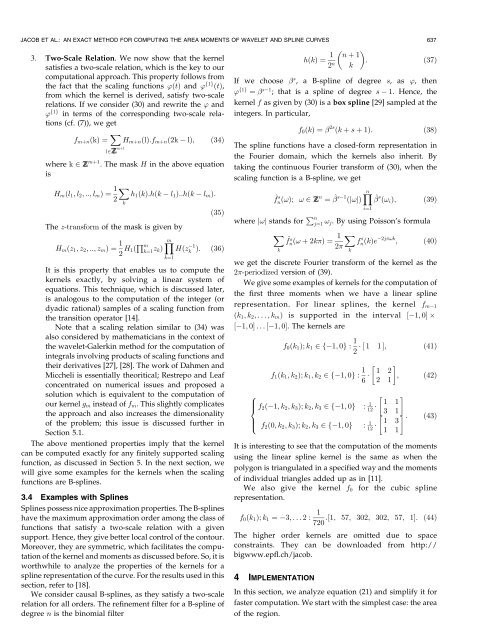An exact method for computing the area moments of ... - IEEE Xplore
An exact method for computing the area moments of ... - IEEE Xplore
An exact method for computing the area moments of ... - IEEE Xplore
- No tags were found...
Create successful ePaper yourself
Turn your PDF publications into a flip-book with our unique Google optimized e-Paper software.
JACOB ET AL.: AN EXACT METHOD FOR COMPUTING THE AREA MOMENTS OF WAVELET AND SPLINE CURVES 6373. Two-Scale Relation. We now show that <strong>the</strong> kernelsatisfies a two-scale relation, which is <strong>the</strong> key to ourcomputational approach. This property follows from<strong>the</strong> fact that <strong>the</strong> scaling functions '…t† and ' f1g …t†,from which <strong>the</strong> kernel is derived, satisfy two-scalerelations. If we consider (30) and rewrite <strong>the</strong> ' and' f1gin terms <strong>of</strong> <strong>the</strong> corresponding two-scale relations(cf. (7)), we getf m‡n …k† ˆXl2 Z m‡1 H m‡n …l†:f m‡n …2k l†;…34†where k 2 Z m‡1 . The mask H in <strong>the</strong> above equationisXH m …l 1 ;l 2 ; ::; l m †ˆ1h 1 …k†:h…k l 1 †::h…k l m †:2k…35†The z-trans<strong>for</strong>m <strong>of</strong> <strong>the</strong> mask is given byH m …z 1 ;z 2 ; ::; z m †ˆ12 H 1… Q mkˆ1 z k† Ymkˆ1H…z 1k †: …36†It is this property that enables us to compute <strong>the</strong>kernels <strong>exact</strong>ly, by solving a linear system <strong>of</strong>equations. This technique, which is discussed later,is analogous to <strong>the</strong> computation <strong>of</strong> <strong>the</strong> integer (ordyadic rational) samples <strong>of</strong> a scaling function from<strong>the</strong> transition operator [14].Note that a scaling relation similar to (34) wasalso considered by ma<strong>the</strong>maticians in <strong>the</strong> context <strong>of</strong><strong>the</strong> wavelet-Galerkin <strong>method</strong> <strong>for</strong> <strong>the</strong> computation <strong>of</strong>integrals involving products <strong>of</strong> scaling functions and<strong>the</strong>ir derivatives [27], [28]. The work <strong>of</strong> Dahmen andMiccheli is essentially <strong>the</strong>oritical; Restrepo and Leafconcentrated on numerical issues and proposed asolution which is equivalent to <strong>the</strong> computation <strong>of</strong>our kernel g m instead <strong>of</strong> f m . This slightly complicates<strong>the</strong> approach and also increases <strong>the</strong> dimensionality<strong>of</strong> <strong>the</strong> problem; this issue is discussed fur<strong>the</strong>r inSection 5.1.The above mentioned properties imply that <strong>the</strong> kernelcan be computed <strong>exact</strong>ly <strong>for</strong> any finitely supported scalingfunction, as discussed in Section 5. In <strong>the</strong> next section, wewill give some examples <strong>for</strong> <strong>the</strong> kernels when <strong>the</strong> scalingfunctions are B-splines.3.4 Examples with SplinesSplines possess nice approximation properties. The B-splineshave <strong>the</strong> maximum approximation order among <strong>the</strong> class <strong>of</strong>functions that satisfy a two-scale relation with a givensupport. Hence, <strong>the</strong>y give better local control <strong>of</strong> <strong>the</strong> contour.Moreover, <strong>the</strong>y are symmetric, which facilitates <strong>the</strong> computation<strong>of</strong> <strong>the</strong> kernel and <strong>moments</strong> as discussed be<strong>for</strong>e. So, it isworthwhile to analyze <strong>the</strong> properties <strong>of</strong> <strong>the</strong> kernels <strong>for</strong> aspline representation <strong>of</strong> <strong>the</strong> curve. For <strong>the</strong> results used in thissection, refer to [18].We consider causal B-splines, as <strong>the</strong>y satisfy a two-scalerelation <strong>for</strong> all orders. The refinement filter <strong>for</strong> a B-spline <strong>of</strong>degree n is <strong>the</strong> binomial filterh…k† ˆ 1 n ‡ 12 n : …37†kIf we choose s , a B-spline <strong>of</strong> degree s, as ', <strong>the</strong>n' f1g ˆ s1 ; that is a spline <strong>of</strong> degree s 1. Hence, <strong>the</strong>kernel f as given by (30) is a box spline [29] sampled at <strong>the</strong>integers. In particular,f 0 …k† ˆ 2s …k ‡ s ‡ 1†:…38†The spline functions have a closed-<strong>for</strong>m representation in<strong>the</strong> Fourier domain, which <strong>the</strong> kernels also inherit. Bytaking <strong>the</strong> continuous Fourier trans<strong>for</strong>m <strong>of</strong> (30), when <strong>the</strong>scaling function is a B-spline, we get^f s n …!†; ! 2 Zn ˆ ^ s1 …j!j† Ynkiˆ1^ s …! i †;…39†where j!j stands <strong>for</strong> P njˆ1 ! j. By using Poisson's <strong>for</strong>mulaX^f n s 1 X…! ‡ 2k† ˆ fn s 2…k†e2j!k ; …40†we get <strong>the</strong> discrete Fourier trans<strong>for</strong>m <strong>of</strong> <strong>the</strong> kernel as <strong>the</strong>2-periodized version <strong>of</strong> (39).We give some examples <strong>of</strong> kernels <strong>for</strong> <strong>the</strong> computation <strong>of</strong><strong>the</strong> first three <strong>moments</strong> when we have a linear splinerepresentation. For linear splines, <strong>the</strong> kernel f m1…k 1 ;k 2 ; ...;k m † is supported in <strong>the</strong> interval ‰1; 0Š‰1; 0Š ...‰1; 0Š. The kernels arekf 0 …k 1 †; k 1 2f1; 0g : 1 ‰1 1Š; …41†2f 1 …k 1 ;k 2 †; k 1 ;k 2 2f1; 0g : 1 6 1 2; …42†2 18 f 2 …1;k 2 ;k 3 †; k 2 ;k 3 2f1; 0g : 1 12 1 1>:1 1…43†It is interesting to see that <strong>the</strong> computation <strong>of</strong> <strong>the</strong> <strong>moments</strong>using <strong>the</strong> linear spline kernel is <strong>the</strong> same as when <strong>the</strong>polygon is triangulated in a specified way and <strong>the</strong> <strong>moments</strong><strong>of</strong> individual triangles added up as in [11].We also give <strong>the</strong> kernel f 0 <strong>for</strong> <strong>the</strong> cubic splinerepresentation.1f 0 …k 1 †; k 1 ˆ3; ...2: :‰1; 57; 302; 302; 57; 1Š: …44†720The higher order kernels are omitted due to spaceconstraints. They can be downloaded from http://bigwww.epfl.ch/jacob.4 IMPLEMENTATIONIn this section, we analyze equation (21) and simplify it <strong>for</strong>faster computation. We start with <strong>the</strong> simplest case: <strong>the</strong> <strong>area</strong><strong>of</strong> <strong>the</strong> region.
















